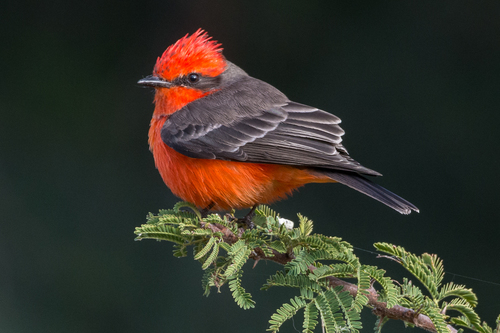
Vermilion Flycatcher
The Vermilion Flycatcher (Pyrocephalus rubinus) is a striking, small passerine bird renowned for the male's brilliant red plumage. This vibrant species plays a vital role in its ecosystem as an insectivore, helping to control insect populations. While not globally threatened, some regional populations face pressures from habitat loss. The bird holds little specific cultural significance beyond its aesthetic appeal, widely admired by birdwatchers and nature enthusiasts for its beauty and lively behavior.
13-14 cm
Length
23-25 cm
Wingspan
Least Concern
Conservation Status
Distribution
The Vermilion Flycatcher's range extends from the southwestern United States through Mexico, Central America, and into South America as far south as Argentina. Some populations are migratory, with northern birds moving south for the winter. Altitudinally, they can be found from sea level to around 3,000 meters.
Lifespan
Typically 3-5 years in the wild.
Vermilion Flycatcher's Habitat
Habitat Types
Riparian woodlands, Savannas, Scrublands, Agricultural areas with scattered trees, Parks and gardens
Climate Zones
Tropical, Subtropical, Temperate
Adaptations
They prefer open habitats with perches for hunting, often near water sources. Their relatively broad, flat bills are adapted for catching insects in flight.
Variations
There are multiple recognized subspecies (around 12-13), differing slightly in plumage and size. For instance, some South American subspecies exhibit darker red coloration in males.
Appearance
Breeding Plumage
Males have bright red underparts and crown, with dark brown upperparts, wings, and tail. Females and immatures are much duller, with grayish-brown upperparts and pale, streaked underparts, often with a yellowish or pinkish wash on the belly. Breeding plumage in males is generally brighter.
Seasonal Feather Changes
Slight, with breeding plumage being more intense.
Sex Based Plumage Differences
Highly pronounced. Males are bright red and brown, while females are much drabber.
Notable Features
Bright red crown and underparts (in males), Short, black bill, Dark brown wings and tail, Erect posture when perched
Diet and Feeding
Primary Foods
Flies, Beetles, Grasshoppers, Bees, Wasps, Butterflies, Moths
Foraging Behavior
Vermilion Flycatchers are primarily aerial insectivores. They typically perch on exposed branches, wires, or other vantage points and sally out to catch flying insects in mid-air. They also occasionally glean insects from foliage.
Specializations
Their wide, flat bill is well-suited for capturing insects in flight. Their agility and quick reflexes allow them to pursue and capture prey with precision.
Seasonal Diet Variations
Diet may shift slightly based on insect availability. During periods of insect scarcity, they may consume more ground-dwelling insects or small spiders.
Behavior
Social Structure
Generally solitary or found in pairs, especially during the breeding season. They may form small, loose flocks outside of the breeding season.
Communication
A high-pitched, chattering song, Various calls, including a sharp 'peent' or 'peet', Visual displays, such as raising their crest feathers
Migration
Some populations are migratory, while others are resident. Northern populations in the U.S. and northern Mexico typically migrate south to Central America and southern Mexico for the winter.
Territorial or Group Behaviors
Males are highly territorial during the breeding season, defending their nesting area against other males. They often engage in aerial chases and vocal disputes.
Conservation
Threats
Habitat loss and degradation (particularly riparian areas), Pesticide use (reducing insect prey), Climate change (potentially affecting breeding success and migration patterns)
Protection Programs
Habitat restoration projects in some areas, General bird conservation initiatives (e.g., promoting bird-friendly practices)
Local National Laws
Protected under the Migratory Bird Treaty Act in the United States.
Population Trend
Stable
Population Estimates
Global population estimated to be around 10 million individuals.
Interesting Facts
The genus name *Pyrocephalus* means 'fire head'.
This refers to the male's brilliant red crown.
Vermilion Flycatchers often return to the same breeding territory year after year.
This site fidelity demonstrates their attachment to specific locations.
Females sometimes incorporate spiderwebs into their nests.
This adds strength and elasticity to the nest structure.
They are known for their acrobatic flight maneuvers when catching insects.
This allows the to catch food mid-air.
They have been observed 'anting,' rubbing ants on their feathers.
This behavior is thought to help control parasites or soothe skin irritation.
Faqs about Vermilion Flycatcher
What do I do if I find a baby Vermilion Flycatcher?
It's best to leave it alone unless it's in immediate danger. The parents are likely nearby and caring for it. If it appears injured, contact a local wildlife rehabilitator. Consult a professional for expert advice.
Are Vermilion Flycatchers endangered?
No, they are currently classified as Least Concern by the IUCN.
How can I attract Vermilion Flycatchers to my yard?
Provide a source of water, plant native trees and shrubs, and avoid using pesticides. Having open areas with perches is also beneficial.
Do Vermilion Flycatchers mate for life?
They are generally monogamous during the breeding season, but it's not definitively known if they pair for life. More research is needed on this aspect of their behavior.
How can I tell a male from a female?
Males have bright red underparts and a red crown, while females are much duller, with grayish-brown upperparts and pale, streaked underparts.
Copyright @ Nature Style Limited. All Rights Reserved.
 English
English